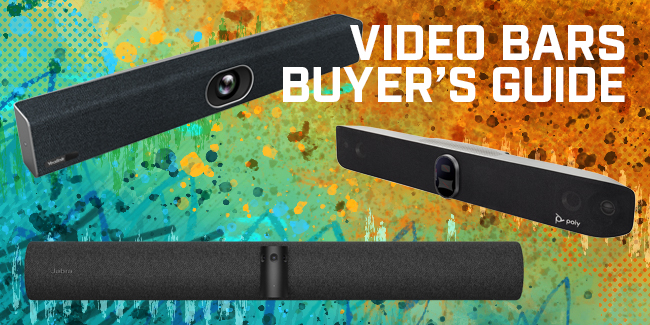
Updated by Jay Brant on February 23, 2024
Video Bars are quickly becoming the go-to solution for professional Video Conferencing in the office. There are two major reasons why: simplicity and cost savings. Rather than forcing you to worry about buying and integrating cameras, microphones, speakers, and other equipment, video bars combine the necessary equipment into one convenient device. And because you’re only buying one device, it can add up to massive cost savings.
That’s why video bars are one of the quickest growing sections of the video conferencing market. In this Video Bars Buyer’s Guide, we cover everything you need to know when shopping for a video bar. We sell business video bars from the leading manufacturers:
For an in-depth introduction to video conferencing, check out our Video Conferencing Buyer’s Guide.
Table of Contents
- What is a video bar?
- Video Bar Camera
- Room Size
- Video Enhancing Technologies
- Video Resolution
- Automatic Speaker Tracking, Automatic Group Framing
- Video Bar Microphones
- Video Bar Speaker
- Video Bar Codec
- Video Bar Compatibility & Video Bar Connectivity
- USB Video Bars
- SIP Video Bars, H.323 Video Bars
- Microsoft Teams Video Bars
- Zoom Video Bars
- Multi-Platform Video Bars
- Video Bar Kits
- Video Bar Connectivity
- How do you mount a video bar?
- Personal Video Bars
- 4 Benefits of Video Bars
What is a video bar?
Video bars are the logical extension of familiar devices. Think of the sound bar you use with your TV. Now picture that sound bar with a built-in video camera and microphone: that’s pretty much a video bar. Or you can think of it as a video conferencing camera with speakers and microphones inside. Or a computer with professional audio/video components built-in.
A video bar always integrates three devices:
Many video bars also integrate a video conferencing codec, which lets you run the video meeting software on the video bar. They can also support extended collaboration features like digital whiteboarding. Let’s take each of these in turn.
Video Bar Camera
As video conferencing for work becomes more and more common, Conference Room Cameras have become a key area of innovation. This holds true for video bars.
When shopping for a video bar, you’ll see models with either one or two cameras. One-camera video bars have wide-angle lenses, which let the camera “see” all the participants. Two-camera video bars have cameras with different focal lengths: one camera is wide-angle, one camera is narrow-angle. The video bar uses whichever one is best for the particular situation, whether that’s by using one for zoom and one for coverage, or for improving automatic speaker tracking, group framing, and so on.
Room Size
Room size is the most important consideration when thinking about a video bar’s camera. For huddle rooms and small rooms, you’ll want a wide-angle camera that can see people closer to the video bar; you don’t need to worry about dual cameras. For large rooms, however, a dual camera video bar can be a real benefit. The narrow-angle camera gives you more facial detail while the wide-angle still captures the whole group.
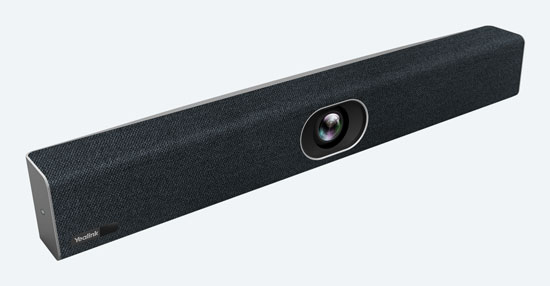
Yealink UVC40 is a plug-and-play USB video bar with 8× ePTZ and AI face enhancement technology, plus automatic speaker tracking and group framing.
Video Enhancing Technologies
Manufacturers have greatly improved conference room camera performance over the years, much of which comes from using better lenses and sensors. But a lot comes down to video enhancing technologies.
HDR (High Dynamic Range) is an important one. Let’s use Jabra’s Vivid HDR that you get with the Jabra PanaCast 50 as an example. “Dynamic range” refers to spectrum of colors from dark to light that the camera is capable of reproducing. HDR technology works by dynamically combining different exposures to compensate for dark or light sections of the picture. In other words, HDR means you see more detail in areas that previously would have been lost in shadow or completely blown out.
Similar to HDR is backlight compensation. This technology means that the camera sets the light levels to people, not, for example, to the bright windows behind them. This way, the people will always be seen and not hidden in shadows.
Many video bars also have automatic white balance, so people’s skin tones look more natural. If you think of how awful fluorescent lights can make people look, you’ll realize how important a technology like Yealink’s AI face enhancement is.

Jabra PanaCast 50 stitches together in real time the three video streams from its three cameras to provide Panoramic 4K video — ultra-ultra-wide angle.
Video Resolution
Just like when you’re shopping for a TV, video resolution is a key question. Nowadays, thats seem to boil down to one decision: 4K or no 4K? 4K Ultra HD means the image includes 4× the number of pixels as 1080p Full HD or 9× the number of pixels as 720p HD for an equivalent image size:
- 720p HD. 1280 × 720 px (1 MP)
- 1080p Full HD. 1920 × 1080 px (2 MP)
- 4K Ultra HD. 3840 × 2160 px (8 MP)
What does “4K Ultra HD” stand for?
When talking about video taken in 16:9 ratio, 4K Ultra HD refers to 3840 × 2160 px resolution. “4K” comes from 3840 being basically 4000. “Ultra HD” or “UHD” is just a marketing term. 720p was labeled “HD” so the next step up, 1080p, became “Full HD.” What’s better than “Full”? Ultra.
Side note: You’ll occasionally see 1080p referred to as “2K” because 1920 is basically 2000.
Increased resolution means finer detail for a given image size. It also means larger file sizes or bandwidth load. Many video conferencing services don’t support 4K video conferencing currently. So do you really need a 4K Ultra HD video bar? Why would you want it?
There are a few reasons you might buy a 4K video bar:
- Future-proofing. Getting a video bar that supports 4K Ultra HD resolution today means that, as business technology progresses as it always does, your video bar will continue to provide first-class performance.
- ePTZ. “ePTZ” stands for “Electronic Pan-Tilt-Zoom.” A traditional PTZ camera physically pans, tilts, and zooms. With ePTZ cameras, the camera focuses in on specific areas by enlarging the picture: essentially, it crops the image. Cropped images can have distracting amounts of pixelation, so having an initial resolution greater than what you’re using for your video call means the camera can electronically zoom in on areas without losing as much, or in some cases any, detail.
- Premium features. Let’s face it: when it comes to technology, some people just want the best specs. 4K Ultra HD is currently the highest-end spec for video bar camera resolution.
If you’re going for 4K, make sure it supports the H.265 video codec, which is a much more efficient standard of compressing video, greatly reducing network load. However, just like 4K isn’t supported everywhere, not all video conferencing services support H.265 right now. H.265 is also known as HEVC (High Efficiency Video Codec).

Yealink MeetingBar A20 for Microsoft Teams is a Microsoft Teams Certified video bar that features an enhanced algorithm to improve its automatic speaker tracking and group framing performance.
Automatic Speaker Tracking, Automatic Group Framing
Two features that really improve the group video call experience are automatic speaker tracking and automatic group framing.
In an ideal world, you’d have a director in the room controlling the flow of the video, cutting between views and zooming in on speakers. But who can pay for a director? Still, having that natural flow to the video part of a video conference would be great. This is why video bars support speaker tracking and group framing:
- Automatic speaker tracking. The camera zooms in on the active speaker, framing them centrally. This allows the far end to see better who’s talking, their facial expression and gestures. It works by using beamforming microphones to pinpoint where speech is coming from. The camera then focuses in on the person.
- Automatic group framing. The camera frames the whole group appropriately, so there isn’t a lot of wasted space in the picture frame, letting the far end see people better. Typically, the video bar will use group framing when no one is speaking. Rather than using microphones, the camera intelligently determines which objects are people and keeps all those objects in the frame.
Manufacturers are improving all the time on the transitions between speaker tracking and group framing. Poly, for example, has developed algorithms that mean the picture moves gracefully between speakers when they’re near to each other. If people are farther apart, the uses a subtle dissolve cut to switch. The hope is that you simply won’t notice anything: the transitions will be as natural as a well-edited TV show.
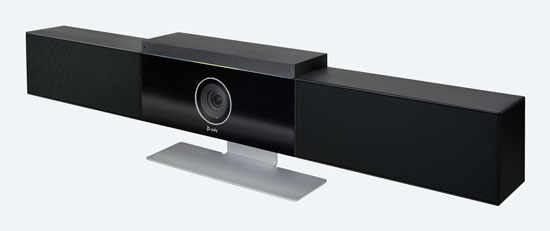
Poly Studio is a plug-and-play USB video bar with a 6-element beamforming microphone array for 12-foot pickup range, perfect for small rooms. It supports Poly’s Acoustic Fence, NoiseBlockAI, and Acoustic Clarity audio enhancing technologies.
Video Bar Microphones
Video bars include microphone arrays for picking up voices. This is convenient, because you won’t need to worry about conference phones, speakerphones, or other external devices.
Many video bars use beamforming microphone arrays. Essentially, this means that the device uses multiple microphones to pinpoint where a voice is coming from: it forms a “beam” to lock in on the voice. It then brings forward that voice in the mix. This both improves microphone reach and reduces how much environmental noise is transmitted.
The most important feature you should be looking for when considering a video bar’s microphone is distance or reach. How far away can people be while still being picked up clearly? How much reach you need is determined by how big the conference room is. In a huddle room, you don’t need much reach. in a large conference room, however, you need much more reach.
Video Bar Expansion Microphones
Even the best video bar can’t cover the whole room sometimes. If you think that’ll be the case, check if the video bar supports expansion microphones, like Poly Studio X70. You lose the all-in-one convenience, but the experience will be that much better.
Note that expansion microphones don’t often come with the video bar: you’ll have to buy them separately.
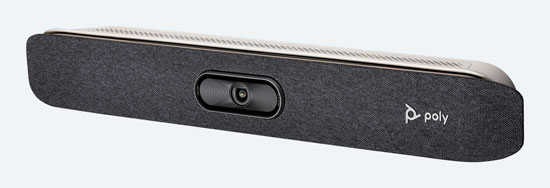
Poly Studio X30 for Zoom Rooms is Zoom Certified for a native experience in huddle rooms. Get professional audio with a beamforming microphone array backed up by NoiseBlockAI and Acoustic Fence.
Noise Reduction Technologies
Because a video bar is placed farther away from the group than a conference phone or speakerphone typically is, manufacturers have really pushed the limits of noise reduction. You should check out what noise reduction a video bar provides if you know you’ll be using it in a noisier environment.
Take Poly as an example. They offer several noise reduction technologies that typify the innovations that allow a video bar to produce professional audio quality.
Acoustic Fence uses the video bar’s microphones to sense how far away sounds are coming from. It then eliminates unwanted sound from beyond a certain distance. In other words, it creates a virtual “fence” around your conversation. Acoustic Fence is particularly useful in noisier environments like open offices or conference rooms next to hallways or cafeterias.
NoiseBlockAI dynamically mutes and unmutes the video bar’s microphones based on whether people on your end are speaking. By muting the microphone, it eliminates any distracting sounds from being transmitted, like the rustling of papers or the crinkling of a snack bag.
These are just two of the types of noise reduction you should pay attention to when shopping for a video bar.
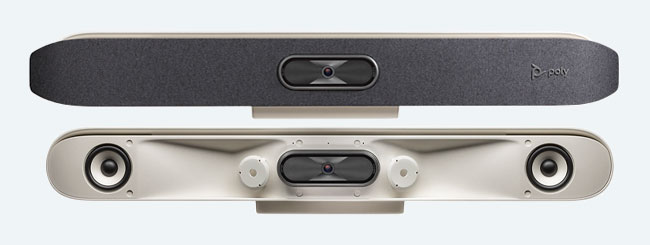
Poly Studio X50, shown here with the grille on and off, uses its high performance stereo speakers with custom acoustic chamber design to provide rich, room-filling sound for medium rooms, plus it supports 4K Ultra HD video and digital whiteboarding.
Video Bar Speakers
Video bars also include speakers, often a stereo speaker array. Because a video bar is used primarily for vocal communication, sound quality isn’t as important as, say, a home stereo. But you still want people to sound good, and for presentations that include video elements, improved audio quality is a desirable feature.
In fact, improved audio quality has been shown to improve comprehension. This is why we recommend you go with a video bar that has a minimum of wideband audio (often called HD audio).
That said, manufacturers are improving video bar speakers, as well. For example, Poly Studio X70 has custom tuned bass ports for more richness and depth and aluminum tweeters for excellent sound in the upper registers.
Video Bar Codec
A number of video bars, like Poly Studio X70, also integrate a video conferencing codec. In this context, a codec is essentially a dedicated computer for running video conferencing software.
Having a video bar with codec simplifies the meeting process when you’re not using it as a USB peripheral (which we cover in just a second). The video bar will natively run, for example, the Microsoft Teams Rooms app, so you don’t need to bring in a laptop. Of course, different video bars support different video conferencing apps, so you’ll need to check on compatibility.
Video Bar Compatibility & Video Bar Connectivity
We’re going to talk now about considerations that go beyond the core video conferencing technologies. As with all technology, the first thing to think about is compatibility.
- USB Video Bars
- SIP Video Bars, H.323 Video Bars
- Microsoft Teams Video Bars
- Zoom Video Bars
- Multi-Platform Video Bars
- Video Bar Kits

Logitech Rally Bar is a plug-and-play USB video bar that delivers exceptional performance in medium rooms with RightSight, RightLight and RightSound technologies. And it comes with a convenient remote control.
USB Video Bars
USB video bars like Poly Studio are the simplest to use. So long as your video conferencing platform supports USB audio/video peripherals, it should work. The experience is the same as using a headset, webcam or other USB device: plug-and-play. You may have to select it under your computer’s or video conferencing service’s audio/video settings. You may find, however, that not every possible feature that the video bar supports is supported by the platform.
Some video conferencing platforms have certification programs to ensure compatibility. We get into two of the most popular of these, Microsoft Teams and Zoom, in just a second.
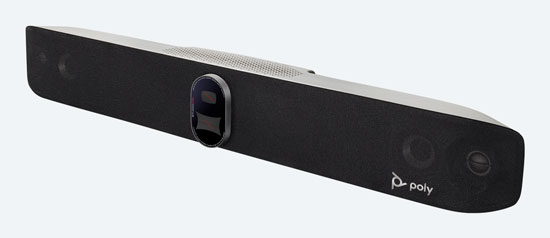
Poly Studio X70 is an elite video bar that supports SIP and H.323. It takes 4K Ultra HD video using two cameras with 20 MP sensors each. Shown here with its motorized electronic privacy shutters closed.
SIP Video Bars, H.323 Video Bars
SIP and H.323 are the most popular standards for open-source video conferencing. Most business video conferencing systems and cloud video conferencing services use one of these protocols for their communications.
There are video bars that support SIP and H.323, rather than being a pure USB peripheral. By supporting these protocols, it means that you can use the video bar with SIP- or H.323-based systems. You’re not locked into one brand’s ecosystem. It also means that you can achieve a professional standard of video communications with the video bar without needing to alter your current setup.
For more on SIP and H.323, check out our Video Conferencing Buyer’s Guide.

Yealink MVC400 is a professional Microsoft Teams video conferencing kit for small rooms with UVC40 video bar plus touch console and mini-PC.
Microsoft Teams Video Bars
Microsoft Teams is perhaps the most popular business video conferencing platform today. Microsoft has a certification program that ensures that the video bar will be automatically identified by the app. It also ensures a high level of audio/video performance, support for call control features, and more.
There are many Microsoft Teams Certified video bars like Yealink MeetingBar A20 for Microsoft Teams (pictured above). There are also Microsoft Teams video conferencing kits like Yealink MVC400.
We recommend you go with a Microsoft Teams video bar if your business uses Microsoft 365 services exclusively. However, if your business has a hybrid environment with multiple platforms, it’s worth it to go with a USB video bar that works across a variety of services.
For an in-depth guide to Microsoft Teams video conferencing, check out our clear, detailed Microsoft Teams Rooms Video Conferencing Equipment Buyer’s Guide.
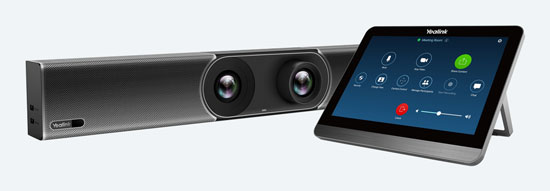
Yealink MeetingBar A30 for Zoom Rooms is a premium, dual camera, Zoom Certified video bar. Designed for medium rooms, its OS is based on Android 9.0 and it’s powered by a Qualcomm Snapdragon 845 chipset. This kit includes a touch console for simple, intuitive control.
Zoom Video Bars
Zoom is so popular now that the word has become a generic term for video conferencing: “Let’s Zoom this afternoon.” Zoom Rooms is great from personal to large room video conferencing. Their certification process guarantees a high level of audio/video performance and full interoperability.
There are quite a few Zoom Certified video bars out there. Poly Studio X30 for Zoom Rooms, for example, is a huddle room video bar that gives your team a plug-and-play solution for Zoom video conferencing.
Multi-platform video bars
Some videos bars let you select the platform you can use the video bar with. For an example of this, check out our blog: How to switch between service providers on Yealink MeetingBar A20 and A30.
Other videos bars can be put in a mode that lets you use them as a USB peripheral, even if they weren’t originally intended for this purpose. For an example of this, check out our blog: What is Poly Device Mode?
Video Bar Kits
While you can use many video bars without needing to buy any other equipment, sometimes you need extra microphone coverage or want a touch controller to manage the video calls. If this is the case, look for a video bar kit.
In particular, Logitech, Poly, and Yealink offer video conferencing kits that provide everything you need to get going. There are options to cover all sizes of conference room, from huddle rooms to extra-large board rooms. Additionally, there are Microsoft Teams Certified video bar kits and Zoom Certified video bar kits that seamlessly integrate with those popular platforms.
(Note that many of these video conferencing bundles don’t actually come with a video bar, they come with other video conferencing equipment.)
Video Bar Connectivity
We’ve just discussed platform compatibility. Now let’s cover physical compatibility, the ports and protocols that allow you to use your video bar how you want. USB video bars, unfortunately, are subject to USB-A/USB-C confusions: you might need an adapter. Beyond USB, there are a few other connectors you might want to check out.
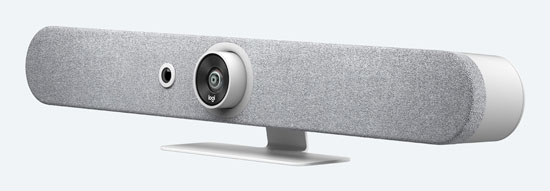
Logitech Rally Bar Mini may be compact but it has dual HDMI ports and supports two displays. Logitech’s RightLight technology means the video is cinema quality.
HDMI
Some video bars have HDMI ports for connecting directly to displays, rather than connecting via USB. Some video bars have dual HDMI ports for dual display conferencing: people and content. Dual display mode gives your video call an extra level of engagement and can improve collaboration.
Bluetooth
Many video bars support wireless Bluetooth connectivity. Bluetooth allows you to connect a smartphone or tablet to the video bar, particularly useful for sharing content. Yealink MeetingEye video bars, for example, let you share content wirelessly via Apple Airplay or Miracast using Bluetooth. Some video bars also support Bluetooth remote controls.
Wi-Fi
Wi-Fi is so convenient you’ll probably be interested in a Wi-Fi video bar. And indeed some video bars support Wi-Fi. But there’s a big caveat: Wi-Fi is typically used for managing the video bar, not for video conferencing itself. Always doublecheck that when a manufacturer says, “This video bar supports Wi-Fi!” they mean what you want them to mean.

Poly Studio X70 comes with a wall mount. Mount it above or below a display using an optional VESA mounting kit that works with up to 85-inch displays, or position it on a table using an optional table stand.
How do you mount a video bar?
An important consideration when shopping for a video bar is: Can you mount it where you want to? There are three basic mounting options for video bars: wall mount, display mount, and table stand. Not every video bar supports all three. When mounting a video bar on a display, you might have a clamp or other built-in thing to hold it stably on top of the display. You might, however, need to use a mounting bracket.
Display mounting brackets typically align with standard VESA patterns. Most displays have VESA mounting patterns on the back, but you’ll want to make sure the display mount fits the back of your display. These mounts will probably allow you to mount the video bar either above or below the display.
If you intend to mount the video bar under a display or on a ceiling, you might look into whether it supports inverted video. This means that you can mount the video bar upside down and it’ll automatically flip the video properly.
Note that you might have to purchase a separate mounting kit. It might not come included in the package. Doublecheck to make sure the video bar can be mounted how you want and whether you’ll have to purchase an additional mounting kit.

Poly Studio P15 is a 4K Ultra HD personal video bar that’s Microsoft Teams and Zoom Certified. This plug-and-play USB-C video bar features a beamforming microphone array, automatic camera framing and a privacy shutter.
Personal Video Bars
To finish up, we wanted to add one thing. We’ve been talking about video bars as if they’re only used for group video communications. There are, however, starting to appear on the market personal video bars like Poly Studio P15.
We all know how bad built-in cameras, microphones and speakers can be on a PC or laptop. Webcams don’t have good microphones and computer speakers, well, don’t help with video at all. A personal video bar upgrades all of them at once: three birds, one stone.
All the features and considerations we’ve discussed in this buyer’s guide apply to personal video bars.
4 Benefits of Video Bars
Let’s sum up why video bars are growing and growing in popularity for business video communications. Here are 4 reasons why video bars are good for you:
- Cost savings. Because you only need the one device, video bars can save you a lot of money compared with traditional video conferencing systems.
- Simplicity. You don’t need to connect all the cameras, microphones and speakers: all-in-one. And this makes it easier for new users to pick up.
- Compatibility. Video bars make it easy to get a professional experience across platforms, including Microsoft Teams and Zoom Rooms Certified options.
- Video and audio quality. Manufacturers have made incredible strides with video enhancing and noise reducing technologies, giving you HD or better video and audio quality.
If you have any questions or for additional help, please contact us at 888.201.9056 or email us at service@ipphone-warehouse.com.
© 2024 IP Phone Warehouse. All rights reserved, including the right to reproduce this Video Bars Buyer’s Guide or portions thereof in any form whatsoever.
